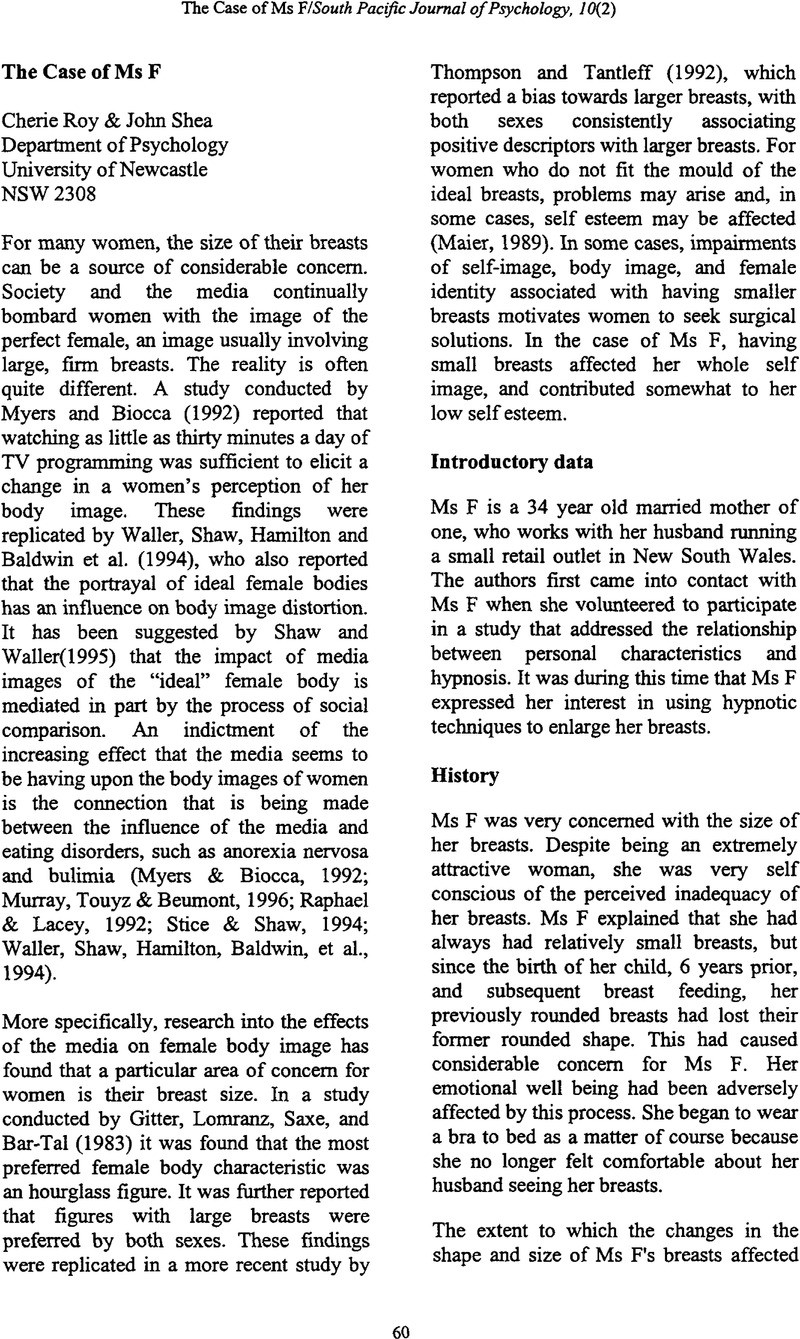No CrossRef data available.
Article contents
The Case of Ms F
Published online by Cambridge University Press: 05 May 2015
Abstract
An abstract is not available for this content so a preview has been provided. Please use the Get access link above for information on how to access this content.

- Type
- Case Studies
- Information
- Copyright
- Copyright © University of Papua New Guinea and the Centre for Southeast Asian Studies, Northern Territory University, Australia 1998
References
Barber, T.X. (1984). Changing unchangeable bodily processes by (hypnotic) suggestions: A new look at hypnosis, cognitions, imaging, and the mind-body problem. Advances, 1(2), 7–40.Google Scholar
Beran, R. (1979, 02). Paper presented at the National Convention of Hypnotherapists, Adelaide, Australia.Google Scholar
Le Cron, L.M. (1969). Breast development through hypnotic suggestion. Journal of the American Society of Psychosomatic Dentistry and Medicine, 76, 58–61.Google Scholar
Maier, C. (1989). Self-perception and the desire for cosmetic breast surgury: The phenomenology and psychodynamics of a sociophobia. Praxis der Psychotherapie und Psychosomatik, 34 (3), 133–142.Google Scholar
Murray, S.H., Touyz, S.W., & Beumont, P.J.V. (1996). Awareness and perceived influence of body ideals in the media: A comparison of eating disorder patients and the general community. Eating Disorders: The Journal of Treatment and Prevention, 4(1), 33–46.CrossRefGoogle Scholar
Myers, P.N., & Biocca, F.A. (1992). The elastic body image: The effect of television advertising and programming on body image distortions in young women. Journal of Communication, 42(3), 108–133.CrossRefGoogle Scholar
Raphael, F.J., & Lacey, J.H. (1992). Sociocultural aspects of eating disorders. Special section: Eating disorders. Annals of Medicine, 24(4), 293–296.CrossRefGoogle Scholar
Shaw, J., & Waller, G. (1995). The medias impact on body image: Implications for prevention and treatment. Special Issue: Body Experience. Eating Disorders: The Journal of Treatment and Prevention, 3(2), 115–123.CrossRefGoogle Scholar
Staib, A.R., & Logan, D.R. (1977). Hypnotic Stimulation of Breast Growth. The American Journal of Clinical Hypnosis, 4, 201–208.CrossRefGoogle Scholar
Stice, E., & Shaw, H.E. (1994). Adverse effects of the media portrayed thin-ideal on women and linkages to bulimic symptomatology. Journal of Social and Clinical Psychology, 13(3), 288–308.CrossRefGoogle Scholar
Thompson, J.K., & Tantleff, S. (1992). Female and male ratings of upper torso: Actual, ideal, and stereotypical conceptions. Journal of Social Behavior and Personality, 7(2), 345–354.Google Scholar
Waller, G., Shaw, J., Hamilton, K., Baldwin, G., et al. (1994). Beauty is in the eye of the beholder: Media influences on the psychopathology of eating problems. Appetite, 23(3), 287.CrossRefGoogle ScholarPubMed
Williams, J.E. (1974). Stimulation of Breast Growth by Hypnosis. Journal of Sex Research, 10, 316–326.CrossRefGoogle Scholar
Willard, R.D. (1977). Breast enlargement through Visual Imagery and Hypnosis. The American Journal of Clinical Hypnosis, 4, 195–200.CrossRefGoogle Scholar
Wilson, D.L. (1979). Natural Bust Enlargement With Total Mind Power: How to use the other 90% of your brain to increase the size of your breasts. Texas: Total Mind Power Institute.Google Scholar




